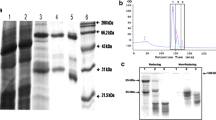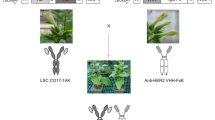Abstract
Field pea (Pisum sativum L.) appears well suited for the production of high-value molecules such as recombinant antibodies, with well-established agricultural practices world-wide and seeds that are easily stored and distributed. In order to evaluate the suitability of this grain legume for the production of biologically active antibodies, we transformed peas with a cDNA encoding the single-chain Fv fragment scFvT84.66. This scFv is derived from the monoclonal antibody T84.66, which recognises the well-characterised tumour-associated carcinoembryonic antigen. The antibody is useful for in vitro immunodiagnosis and in vivo imaging of human cancers. We expressed scFvT84.66 cDNA under the control of the seed-specific legumin A promoter. We targeted the antibody to the endoplasmic reticulum for better stability and high accumulation. Transgenic plants produced up to 9 μg per gram fresh weight of functional scFvT84.66 in their seeds. The transgene was stably inherited and expressed in the progeny, and the antibody remained active after storage in dried transgenic seeds for two months at room temperature. Our results demonstrate the suitability of grain legume seeds to produce biologically active recombinant antibodies, and the utility of field pea seeds as production vehicles for recombinant pharmaceutical macromolecules.
Similar content being viewed by others
References
Artsaenko O, Kettig B, Fiedler U, Conrad U, Duering K: Potato tubers as a biofactory for recombinant antibodies. Mol Breed 4: 313–319 (1998).
Bean SJ, Gooding PS, Mullineaux PM, Davies DR: A simple system for pea transformation. Plant Cell Rep 16: 513–519 (1997).
Biocca S, Ruberti F, Tafani M, Pierandrei-Amaldi P, Cattaneo A: Redox state of single-chain Fv fragments targeted to the endoplasmic reticulum, cytosol and mitochondria. Bio/technology 13: 1110–1115 (1995).
Conrad U, Fiedler U: Compartment-specific accumulation of recombinant immunoglobulins in plant cells: an essential tool for antibody production and immunomodulation of physiological functions and pathogen activity. Plant Mol Biol 38: 101–109 (1998).
De Block M, Botterman J, Vandewiele M, Dockx J, Thoen C, Gossele V, Rao Movva N, Thompson C, Van Montagu M, Leemans J: Engineering herbicide resistance in plants by expression of a detoxifying enzyme. EMBO J 6: 2513–2518 (1987).
Dellaporta SL, Wood J, Hicks JB: </del>Maize DNA miniprep. In Malmberg R, Messing J, Sussex I (eds) Molecular Biology of Plants: A Laboratory Course Manual, pp. 36–37. Cold Spring Harbor Laboratory Press, Cold Spring Harbor, NY (1984).
Denecke J, de Rycke R, Botterman J: Plant and mammalian sorting signals for protein retention in the endoplasmic reticulum contain a conserved epitope. EMBO J 11: 2345–2355 (1992).
Domoney C, Welham T: Genetic manipulation of enzyme inhibitors in pea seeds. In Jansman AMJ, Hill GD, Huisman J, van der Poel AFP (eds) Recent Advances of Research in Antinutritional Factors in Legume Seeds and Rapeseed. Proceedings of the 3rd International Workshop on Antinutritional Factors in Legume Seeds and Rapeseed. EAAP publication 93, pp. 369-373. Wageningen Press (1998).
Fiedler U, Conrad U: High-level production and long-term storage of engineered antibodies in transgenic tobacco seeds. Bio/technology 13: 1090–1093 (1995).
Fiedler U, Phillips J, Artsaenko O, Conrad U: Optimisation of scFv antibody production in transgenic plants. Immunotechnology 3: 205–216 (1997).
Firek S, Draper J, Owen MRL, Gandecha A, Cockburn B, Whitelam GC: Secretion of a functional single-chain Fv protein in transgenic tobacco plants and cell suspension cultures. Plant Mol Biol 23: 861–870 (1993).
Fischer R, Drossard J, Liao YC, Schillberg S: Characterisation and application of plant-derived recombinant antibodies. In Cunningham C, Porter A (Eds.) Methods in Biotechnology. Recombinant Proteins from Plants: Production and Isolation of Clinically Useful Compounds, pp. 121–147. Humana Press, Totowa, NJ (1998).
Gallie DR, Walbot V: Identification of the motifs within the tobacco mosaic virus 50-leader responsible for enhancing translation. Nucl Acids Res 20: 4631–4638 (1992).
Goddijn OJM, Pen J: Plants as bioreactors. Trends Biotechnol 13: 379–387 (1995).
Hiatt A, Cafferkey R, Bowdish K: Production of antibodies in transgenic plants. Nature 342: 469–470 (1989).
Hood EE, Witcher DR, Maddock S, Meyer T, Baszczynski C, Bailey M, Flynn P, Register J, Marshall L, Bond D, Kulisek E, Kusnadi A, Evangelista R, Nikolov Z, Wooge C, Mehigh RJ, Hernan R, Kappel WK, Ritland D, Li CP, Howard JA: Commercial production of avidin from transgenic maize: characterization of transformant, production, processing, extraction and purification. Mol Breed 3: 291–306 (1997).
Kusnadi AR, Nikolov ZL, Howard JA: Production of recombinant proteins in transgenic plants: practical considerations. Biotechnol Bioeng 56: 473–484 (1997).
Lycett GW, Croy RRD, Shirsat AH, Boulter D: The complete nucleotide sequence of a legumin gene from pea (Pisum sativum L.). Nucl Acids Res 12: 4493–4506 (1984).
Ma JK-C, Hiatt A, Hein MB, Vine N, Wang F, Stabila P, van Dollewerd C, Mostov K, Lehner T: Generation and assembly of secretory antibodies in plants. Science 268: 716–719 (1995).
Murray EE, Lotzer J, Eberle M: Codon usage in plant genes. Nucl Acids Res 17: 477–498 (1989).
Neumaier M, Shively L, Chen FS, Gaida FJ, Ilgen C, Paxton RJ, Shively JE, Riggs AD: Cloning of the genes for T84.66, an antibody that has high specificity and affinity for carcinoembryonic antigen, and expression of chimeric human mouse T84.66 genes in myeloma and Chinese hamster ovary cells. Cancer Res 50: 2128–2134 (1990).
Owen M, Gandecha A, Cockburn B, Whitelam G: Synthesis of a functional anti-phytochrome single-chain Fv protein in transgenic tobacco. Bio/technology 10: 790–794 (1992).
Plückthun A: Antibody engineering. Curr Opin Biotechnol 2: 238–246 (1991).
Russel DA: Feasibility of antibody production in plants for human therapeutic use. In: Hammond J, McGarvey P, Yusibov V (Eds) Plant Biotechnology-New Products and Applications, pp. 44–58. Springer-Verlag, New York (1999).
Saalbach I, Bäumlein H, Czihal A, Conrad B, Herbers K, Hofemeister J, Hoffmeister P, Müntz K, Sonnewald U, Waddel D: Expression of bacterial enzymes in the field pea for industrial production. In: Gene Expression, Metabolic Integration and Phytofarming, 7th International Seed Protein Meeting, Gatersleben (Germany), 24-26 June (1997).
Sambrook J, Fritsch EF, Maniatis T: Molecular Cloning: A Laboratory Manual, (2nd edn). Cold Spring Harbor Laboratory Press, Cold Spring Harbor, NY (1989).
Schouten A, Roosien J, van Engelen FA, de Jong GAM, Borst-Vrenssen AWM, Zilverentant JF, Bosch D, Stiekema WJ, Gommers FJ, Schots A, Bakker J: The C-terminal KDEL sequence increases the expression level of a single-chain antibody designed to be targeted to both cytosol and the secretory pathway in transgenic tobacco. Plant Mol Biol 30: 781–793 (1996).
Schroeder HE, Gollasch S, Tabe L, Moore A, Spencer D, Higgins TJV: The expression and stability of transgenes in peas (Pisum sativum L.). In: {ieAEP} (Eds.) Improving Production and Utilisation of Grain Legumes. Proceedings of the 2nd European Conference on Grain Legumes, Copenhagen, Denmark, 9-13 July, pp. 422–423 (1995).
Schroeder HE, Gollasch S, Moore A, Tabe LM, Craig S, Hardie DC, Chrispeels MJ, Spencer D, Higgins TJV: Bean?-amylase inhibitor confers resistance to the pea weevil (Bruchus pisurum) in transgenic peas (Pisum sativum L.). Plant Physiol 107: 1233–1239 (1995).
Steiger M, Neuhaus G, Takiyoshi M, Schell J, Kreuzaler F: Self assembly of immunoglobulins in the cytoplasm of the alga Acetabularia mediterranea. Plant Sci 73: 181–190 (1991).
Stoger E, Vaquero C, Torres E, Sack M, Nicholson L, Drossard J, Williams S, Keen D, Perrin Y, Christou P, Fischer R: Cereal crops as viable production and storage systems for pharmaceutical scFv antibodies. Plant Mol Biol 42: 583–590 (2000).
Tavladoraki P, Benvenuto E, Trinca S, de Martinis D, Galeffi P: Transgenic plants expressing a functional single-chain Fv antibody are specifically protected from virus attack. Nature 366: 469–472 (1993).
Van der Logt CPE, Sidebottom CS, Davis PJ: Antibody production in plants. In: Shewry PR, Napier JA, Davis PJ (Eds.) Engineering Crop Plants for Industrial End Uses, pp. 17–33. Portland Press, New York (1998).
Vaquero C, Sack M, Chandler J, Drossard J, Schuster F, Monecke M, Schillberg S, Fischer R: Transient expression of a tumor-specific single-chain fragment and a chimeric antibody in tobacco leaves. Proc Natl Acad Sci USA 96: 11128–11133 (1999).
Voss A, Niersbach M, Hain R, Hirsch HJ, Liao YC, Kreuzaler F, Fischer R: Reduced virus infectivity in N. tabacum secreting a TMV-specific full-size antibody. Mol Breed 1: 39–50 (1995).
Wu AM, Chen W, Raubitschek A, Williams LE, Neumaier M, Fischer R, Hu S, Odom-Maryon T, Wong JYC, Shively JE: Tumour localisation of anti-CEA single-chain Fvs: improved targeting by non-covalent dimers. Immunotechnology 2: 21–36 (1996).
Zeitlin L, Olmsted SS, Moench TR, Co MS, Martinell BJ, Paradkar VM, Russell DR, Queen C, Cone RA, Whaley KJ: A humanised monoclonal antibody produced in transgenic plants for immunoprotection of the vagina against genital herpes. Nature Biotechnol 16: 1361–1364 (1998).
Zhong GY, Peterson D, Delaney DE, Bailey M, Witcher DR, Register III JC, Bond D, Li CP, Marshall L, Kulisek E, Ritland D, Meyer T, Hood EE, Howard JA: Commercial production of aprotinin in transgenic maize seeds. Mol Breed 5: 345–356 (1999).
Zimmermann S, Schillberg S, Liao YC, Fischer R: Intracellular expression of TMV-specific single-chain Fv fragments leads to improved virus resistance in Nicotiana tabacum. Mol Breed 4: 369–379 (1998).
Author information
Authors and Affiliations
Rights and permissions
About this article
Cite this article
Perrin, Y., Vaquero, C., Gerrard, I. et al. Transgenic pea seeds as bioreactors for the production of a single-chain Fv fragment (scFV) antibody used in cancer diagnosis and therapy. Molecular Breeding 6, 345–352 (2000). https://doi.org/10.1023/A:1009657701588
Issue Date:
DOI: https://doi.org/10.1023/A:1009657701588




